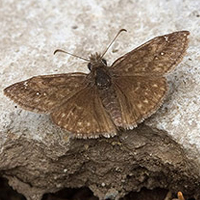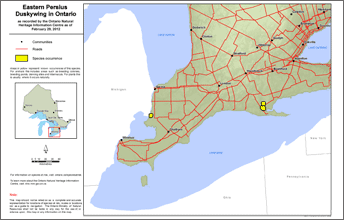Eastern persius duskywing
Scientific name: Erynnis persius persius

Cover photo credit: Tim Gibb
Status
Extirpated
“Extirpated” means the species lives somewhere in the world, and at one time lived in the wild in Ontario, but no longer lives in the wild in Ontario.
Date added to the Species at Risk in Ontario List
The Eastern Persius Duskywing was already listed as extirpated when the Endangered Species Act took effect in 2008. A reassessment in December 2016 confirmed this status.
Read the assessment report (PDF)
What it looks like
The Eastern Persius Duskywing is a small, brown butterfly with four tiny white spots on the upper side of the forewings. It belongs to a group of butterflies known as skippers, which have short, rapid and erratic flight behaviour, and antenna clubs that are hooked backwards like a crochet hook. Caterpillars are light green, covered with fine, short hairs and have brownish black heads.
Where it lives
The Eastern Persius Duskywing is found in open oak savannah, pine barren and prairie habitats with populations of wild lupine and wild indigo, the larval host plants.
Where it’s been found in Ontario
The populations of this rare butterfly are declining throughout its North American range, which extends from the north Atlantic states, west to Wisconsin and south to Virginia. It is considered to be extirpated from Maine and has not been reported in Maryland, New Jersey or New York since the 1990s.
In Canada, the Eastern Persius Duskywing range is limited to two sites (one in Norfolk County and one in Lambton County) in southwestern Ontario. There have been no confirmed sightings here since 1987.
View a Larger version of this map (PDF)
Why it disappeared from Ontario
Much of Ontario’s original savannah or barrens habitat has been destroyed by development or taken over, through natural succession, by plants that create shady conditions. These conditions impede the growth of the wild lupine and yellow indigo plants, which require open, sunny areas and are the only known host plants for the caterpillars of this butterfly.
Action we are taking
Extirpated species and their habitat are protected if the species are again found in Ontario.
Help make sure we don’t lose more endangered species in Ontario
- The Ministry of Natural Resources and Forestry tracks species at risk such as the Eastern Persius Duskywing. You can use a handy online form to report your sightings to the Natural Heritage Information Centre. Photographs with specific locations or mapping coordinates are always helpful.
- Private land owners have an important role to play in species recovery. You may be eligible for stewardship programs that support the protection and recovery of species at risk and their habitats. For more information visit: www.ontario.ca/speciesatrisk.
- Report any illegal activity related to plants and wildlife to
1-877-847-7667 . - Private land owners have an important role to play in species recovery. You may be eligible for stewardship programs that support the protection and recovery of species at risk and their habitats.
- Volunteer with a local nature club or provincial park to participate in surveys or stewardship work focused on species at risk.
Quick facts
- In Ontario, the Eastern Persius Duskywing was first collected in 1969 and was last reported in 1987.
- Wild lupines and wild indigo are the only known host plants for the Eastern Persius Duskywing. Because these host plants are associated with savannah and barren habitats, this butterfly represents a rare and declining habitat type in both Ontario and North America.
- Other species of butterflies, the Karner Blue and Frosted Elfin, that rely heavily on lupine as a food source have experienced similar population declines as the Eastern Persius Duskywing and are also extirpated in Ontario.
